MGMT690-1703A-02 Discussion: Global Strategy, Australia Expansion
VerifiedAdded on 2023/06/03
|5
|1039
|413
Discussion Board Post
AI Summary
This discussion board post defines global strategy and compares it to multi-domestic and transnational strategies. It discusses globalization, focusing on potential expansion opportunities in Australia, New Zealand, and China, ultimately selecting Australia due to its receptive market and favorable trade policies. The analysis includes pros and cons of expanding into these countries, highlighting the importance of minimizing costs and addressing environmental regulations. The post references academic sources to support its arguments regarding international business strategy and market entry.
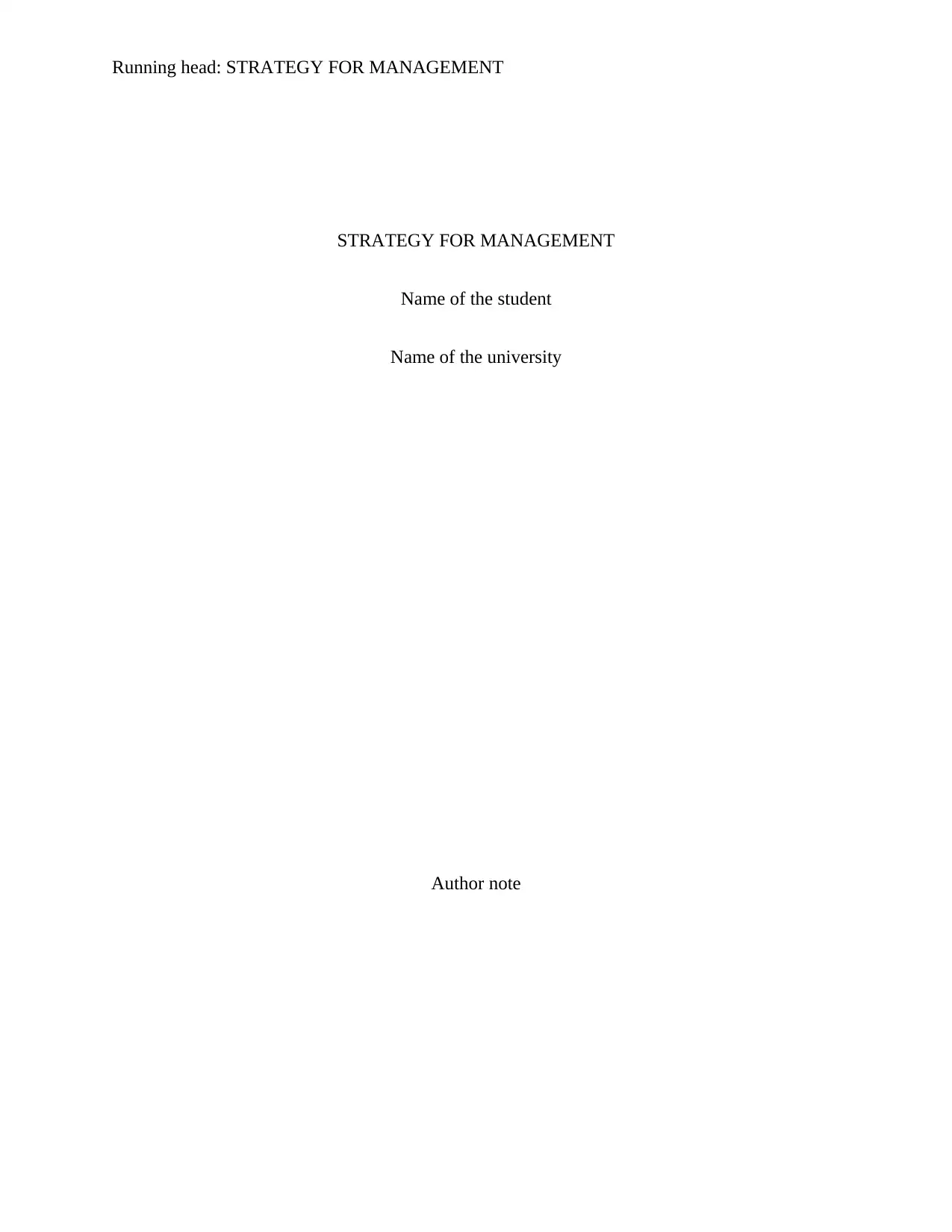
Running head: STRATEGY FOR MANAGEMENT
STRATEGY FOR MANAGEMENT
Name of the student
Name of the university
Author note
STRATEGY FOR MANAGEMENT
Name of the student
Name of the university
Author note
Paraphrase This Document
Need a fresh take? Get an instant paraphrase of this document with our AI Paraphraser
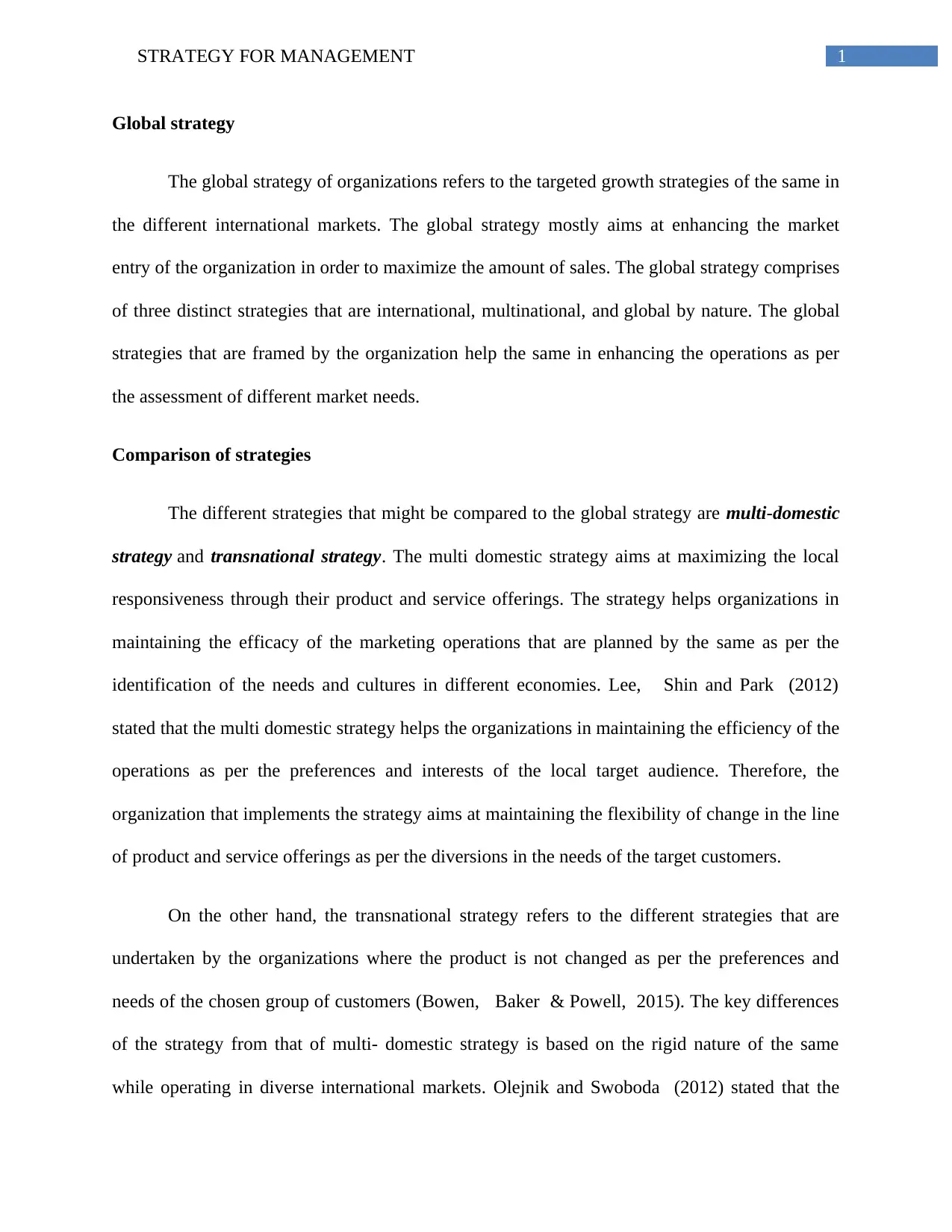
1STRATEGY FOR MANAGEMENT
Global strategy
The global strategy of organizations refers to the targeted growth strategies of the same in
the different international markets. The global strategy mostly aims at enhancing the market
entry of the organization in order to maximize the amount of sales. The global strategy comprises
of three distinct strategies that are international, multinational, and global by nature. The global
strategies that are framed by the organization help the same in enhancing the operations as per
the assessment of different market needs.
Comparison of strategies
The different strategies that might be compared to the global strategy are multi-domestic
strategy and transnational strategy. The multi domestic strategy aims at maximizing the local
responsiveness through their product and service offerings. The strategy helps organizations in
maintaining the efficacy of the marketing operations that are planned by the same as per the
identification of the needs and cultures in different economies. Lee, Shin and Park (2012)
stated that the multi domestic strategy helps the organizations in maintaining the efficiency of the
operations as per the preferences and interests of the local target audience. Therefore, the
organization that implements the strategy aims at maintaining the flexibility of change in the line
of product and service offerings as per the diversions in the needs of the target customers.
On the other hand, the transnational strategy refers to the different strategies that are
undertaken by the organizations where the product is not changed as per the preferences and
needs of the chosen group of customers (Bowen, Baker & Powell, 2015). The key differences
of the strategy from that of multi- domestic strategy is based on the rigid nature of the same
while operating in diverse international markets. Olejnik and Swoboda (2012) stated that the
Global strategy
The global strategy of organizations refers to the targeted growth strategies of the same in
the different international markets. The global strategy mostly aims at enhancing the market
entry of the organization in order to maximize the amount of sales. The global strategy comprises
of three distinct strategies that are international, multinational, and global by nature. The global
strategies that are framed by the organization help the same in enhancing the operations as per
the assessment of different market needs.
Comparison of strategies
The different strategies that might be compared to the global strategy are multi-domestic
strategy and transnational strategy. The multi domestic strategy aims at maximizing the local
responsiveness through their product and service offerings. The strategy helps organizations in
maintaining the efficacy of the marketing operations that are planned by the same as per the
identification of the needs and cultures in different economies. Lee, Shin and Park (2012)
stated that the multi domestic strategy helps the organizations in maintaining the efficiency of the
operations as per the preferences and interests of the local target audience. Therefore, the
organization that implements the strategy aims at maintaining the flexibility of change in the line
of product and service offerings as per the diversions in the needs of the target customers.
On the other hand, the transnational strategy refers to the different strategies that are
undertaken by the organizations where the product is not changed as per the preferences and
needs of the chosen group of customers (Bowen, Baker & Powell, 2015). The key differences
of the strategy from that of multi- domestic strategy is based on the rigid nature of the same
while operating in diverse international markets. Olejnik and Swoboda (2012) stated that the
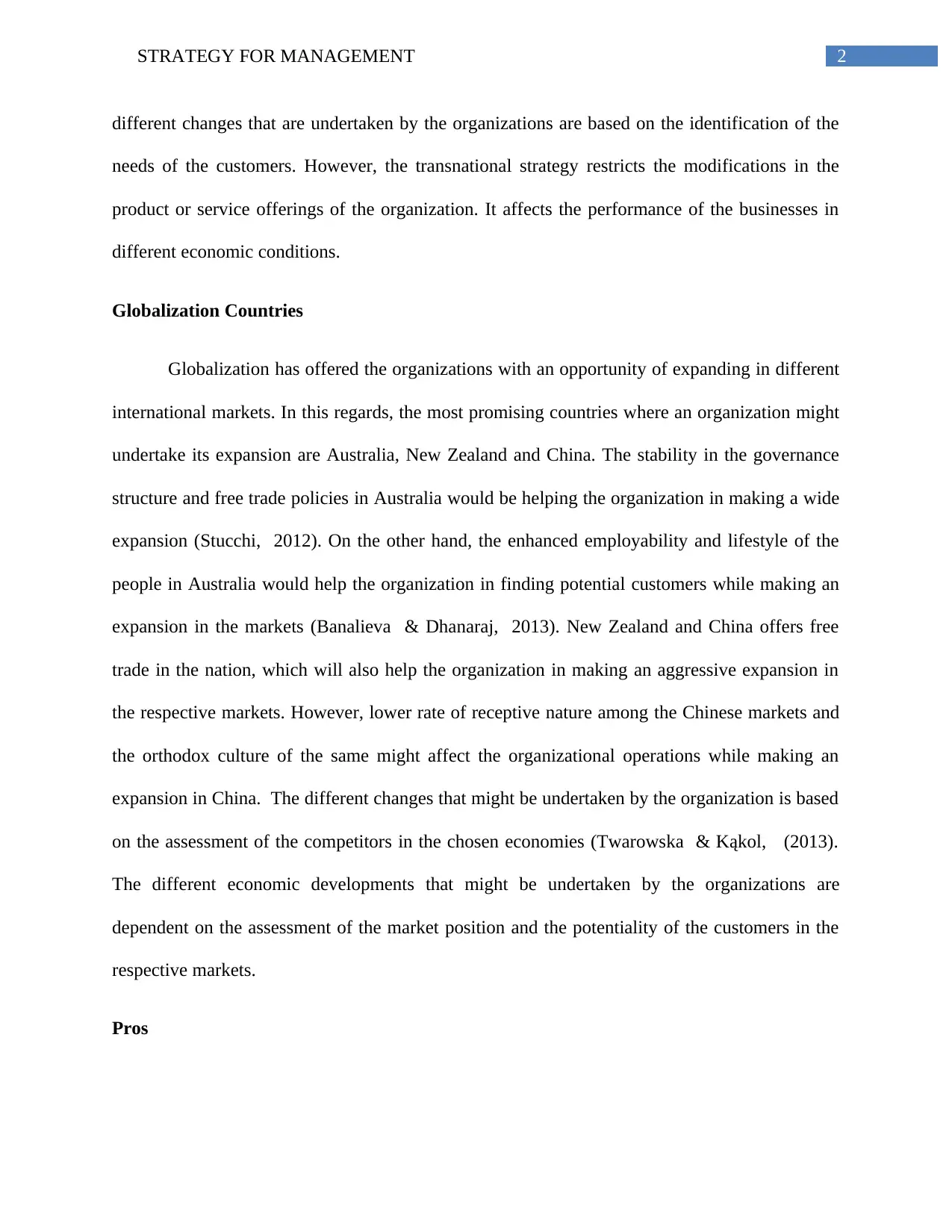
2STRATEGY FOR MANAGEMENT
different changes that are undertaken by the organizations are based on the identification of the
needs of the customers. However, the transnational strategy restricts the modifications in the
product or service offerings of the organization. It affects the performance of the businesses in
different economic conditions.
Globalization Countries
Globalization has offered the organizations with an opportunity of expanding in different
international markets. In this regards, the most promising countries where an organization might
undertake its expansion are Australia, New Zealand and China. The stability in the governance
structure and free trade policies in Australia would be helping the organization in making a wide
expansion (Stucchi, 2012). On the other hand, the enhanced employability and lifestyle of the
people in Australia would help the organization in finding potential customers while making an
expansion in the markets (Banalieva & Dhanaraj, 2013). New Zealand and China offers free
trade in the nation, which will also help the organization in making an aggressive expansion in
the respective markets. However, lower rate of receptive nature among the Chinese markets and
the orthodox culture of the same might affect the organizational operations while making an
expansion in China. The different changes that might be undertaken by the organization is based
on the assessment of the competitors in the chosen economies (Twarowska & Kąkol, (2013).
The different economic developments that might be undertaken by the organizations are
dependent on the assessment of the market position and the potentiality of the customers in the
respective markets.
Pros
different changes that are undertaken by the organizations are based on the identification of the
needs of the customers. However, the transnational strategy restricts the modifications in the
product or service offerings of the organization. It affects the performance of the businesses in
different economic conditions.
Globalization Countries
Globalization has offered the organizations with an opportunity of expanding in different
international markets. In this regards, the most promising countries where an organization might
undertake its expansion are Australia, New Zealand and China. The stability in the governance
structure and free trade policies in Australia would be helping the organization in making a wide
expansion (Stucchi, 2012). On the other hand, the enhanced employability and lifestyle of the
people in Australia would help the organization in finding potential customers while making an
expansion in the markets (Banalieva & Dhanaraj, 2013). New Zealand and China offers free
trade in the nation, which will also help the organization in making an aggressive expansion in
the respective markets. However, lower rate of receptive nature among the Chinese markets and
the orthodox culture of the same might affect the organizational operations while making an
expansion in China. The different changes that might be undertaken by the organization is based
on the assessment of the competitors in the chosen economies (Twarowska & Kąkol, (2013).
The different economic developments that might be undertaken by the organizations are
dependent on the assessment of the market position and the potentiality of the customers in the
respective markets.
Pros
⊘ This is a preview!⊘
Do you want full access?
Subscribe today to unlock all pages.

Trusted by 1+ million students worldwide
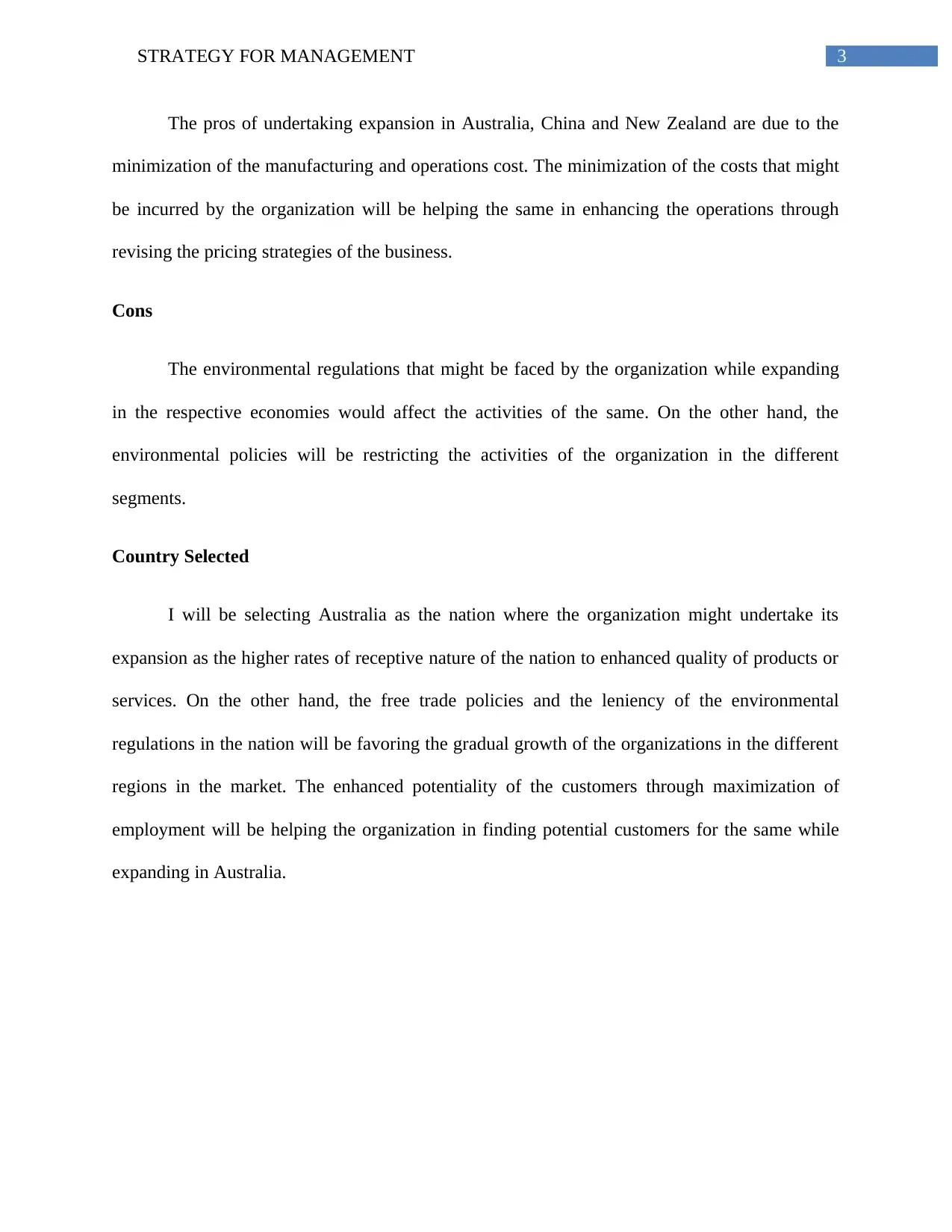
3STRATEGY FOR MANAGEMENT
The pros of undertaking expansion in Australia, China and New Zealand are due to the
minimization of the manufacturing and operations cost. The minimization of the costs that might
be incurred by the organization will be helping the same in enhancing the operations through
revising the pricing strategies of the business.
Cons
The environmental regulations that might be faced by the organization while expanding
in the respective economies would affect the activities of the same. On the other hand, the
environmental policies will be restricting the activities of the organization in the different
segments.
Country Selected
I will be selecting Australia as the nation where the organization might undertake its
expansion as the higher rates of receptive nature of the nation to enhanced quality of products or
services. On the other hand, the free trade policies and the leniency of the environmental
regulations in the nation will be favoring the gradual growth of the organizations in the different
regions in the market. The enhanced potentiality of the customers through maximization of
employment will be helping the organization in finding potential customers for the same while
expanding in Australia.
The pros of undertaking expansion in Australia, China and New Zealand are due to the
minimization of the manufacturing and operations cost. The minimization of the costs that might
be incurred by the organization will be helping the same in enhancing the operations through
revising the pricing strategies of the business.
Cons
The environmental regulations that might be faced by the organization while expanding
in the respective economies would affect the activities of the same. On the other hand, the
environmental policies will be restricting the activities of the organization in the different
segments.
Country Selected
I will be selecting Australia as the nation where the organization might undertake its
expansion as the higher rates of receptive nature of the nation to enhanced quality of products or
services. On the other hand, the free trade policies and the leniency of the environmental
regulations in the nation will be favoring the gradual growth of the organizations in the different
regions in the market. The enhanced potentiality of the customers through maximization of
employment will be helping the organization in finding potential customers for the same while
expanding in Australia.
Paraphrase This Document
Need a fresh take? Get an instant paraphrase of this document with our AI Paraphraser
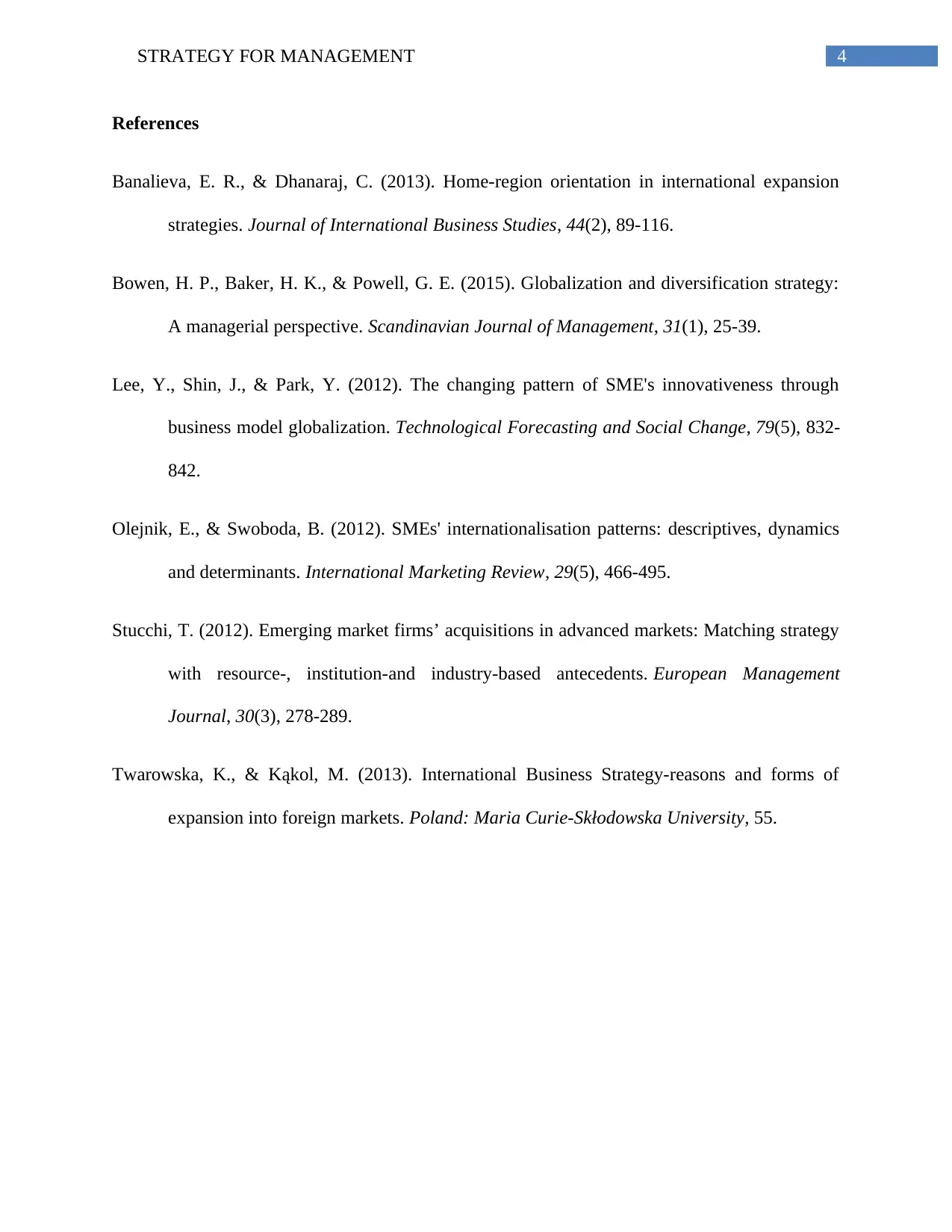
4STRATEGY FOR MANAGEMENT
References
Banalieva, E. R., & Dhanaraj, C. (2013). Home-region orientation in international expansion
strategies. Journal of International Business Studies, 44(2), 89-116.
Bowen, H. P., Baker, H. K., & Powell, G. E. (2015). Globalization and diversification strategy:
A managerial perspective. Scandinavian Journal of Management, 31(1), 25-39.
Lee, Y., Shin, J., & Park, Y. (2012). The changing pattern of SME's innovativeness through
business model globalization. Technological Forecasting and Social Change, 79(5), 832-
842.
Olejnik, E., & Swoboda, B. (2012). SMEs' internationalisation patterns: descriptives, dynamics
and determinants. International Marketing Review, 29(5), 466-495.
Stucchi, T. (2012). Emerging market firms’ acquisitions in advanced markets: Matching strategy
with resource-, institution-and industry-based antecedents. European Management
Journal, 30(3), 278-289.
Twarowska, K., & Kąkol, M. (2013). International Business Strategy-reasons and forms of
expansion into foreign markets. Poland: Maria Curie-Skłodowska University, 55.
References
Banalieva, E. R., & Dhanaraj, C. (2013). Home-region orientation in international expansion
strategies. Journal of International Business Studies, 44(2), 89-116.
Bowen, H. P., Baker, H. K., & Powell, G. E. (2015). Globalization and diversification strategy:
A managerial perspective. Scandinavian Journal of Management, 31(1), 25-39.
Lee, Y., Shin, J., & Park, Y. (2012). The changing pattern of SME's innovativeness through
business model globalization. Technological Forecasting and Social Change, 79(5), 832-
842.
Olejnik, E., & Swoboda, B. (2012). SMEs' internationalisation patterns: descriptives, dynamics
and determinants. International Marketing Review, 29(5), 466-495.
Stucchi, T. (2012). Emerging market firms’ acquisitions in advanced markets: Matching strategy
with resource-, institution-and industry-based antecedents. European Management
Journal, 30(3), 278-289.
Twarowska, K., & Kąkol, M. (2013). International Business Strategy-reasons and forms of
expansion into foreign markets. Poland: Maria Curie-Skłodowska University, 55.
1 out of 5
Related Documents
Your All-in-One AI-Powered Toolkit for Academic Success.
+13062052269
info@desklib.com
Available 24*7 on WhatsApp / Email
![[object Object]](/_next/static/media/star-bottom.7253800d.svg)
Unlock your academic potential
Copyright © 2020–2025 A2Z Services. All Rights Reserved. Developed and managed by ZUCOL.





